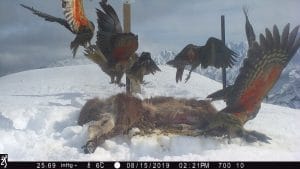In early 2018, Zero Invasive Predators (ZIP) attached transmitters to 31 kea in the Perth Valley. This was part of a study looking at kea mortality throughout 1080 operations taking place in the winter of 2019. Of these 31 kea, 10 were adult and sub-adult females at the time of first capture (9 of which had active transmitters prior to the start of the operation). Of the 13 kea present in the dropzone during the first 1080 operation, 11 survived. All 12 kea present during the second drop, survived (including 7 females)
The last ZIP Skyranger tracking flight in 2019 located 3 of the 7 adult female kea within the operational zone. These kea will be followed in subsequent years to ascertain breeding success. Additionally, the KCT will aim to catch up kea with high blood lead levels so that they can receive treatment and where possible, to remove all lead accessible to kea.

Project Outcomes
4th - 7th January, 2020
Area Covered: Upper Barlow catchment and upper Perverse Creek.
Seven kea were caught over the 4 days – one recapture and six new captures. Lead samples were obtained from all individuals. Three of the samples contained high lead concentrations (>20μg/dL). These included an adult female (30.2μg/dL), a subadult male (31.4μg/dL) and a juvenile male (31.3μg/dL).
Telemetry signals were checked from both catch sites and seven kea were detected including one on mortality mode. No nesting signals were obtained from adult females. Approximate locations of kea were estimated from the catch sites.
Future work:
In order to obtain a useful sample of blood lead data (currently n=7) a further catch trip would be useful. Many birds were originally caught in 2018 at sites in the Perth Valley (this trip focused on Barlow) so it may be useful to return to Adverse Creek and Teichelman Stream sites where teams were previously based in order to attempt to gain some recaptures. Depending on the time of year this trip could coincide with a nest searching trip to track adult females with transmitters. A further trip could also retrieve the transmitter (TR4 CH5) that is on mortality mode.
12th - 16th October, 2019
Aims: Locate radio-tagged females to ascertain breeding activity. Locate any other radio-tagged and banded individuals (particularly those known to have high blood lead levels).
Outcomes: Of the seven transmittered females, three active kea and one transmitter on a mortality pulse rate were located throughout the trip. Only one signal for the mortality-mode transmitter was gained (from Abel Lake). This indicated that the transmitter was located high up The Great Unknown – an inaccessible area without climbing equipment. It is likely that this is a dropped transmitter and not a kea mortality.
Two of the three active kea were located near Teichelmann Biv. One showed high activity on its data output and was clearly moving about in the valley at the time of tracking. The other was emitting a nesting pulse rate. Unfortunately, after tracking this kea to a point in the alpine, she was found to not be nesting. The low activity from her data output suggests that she may be ready to nest.